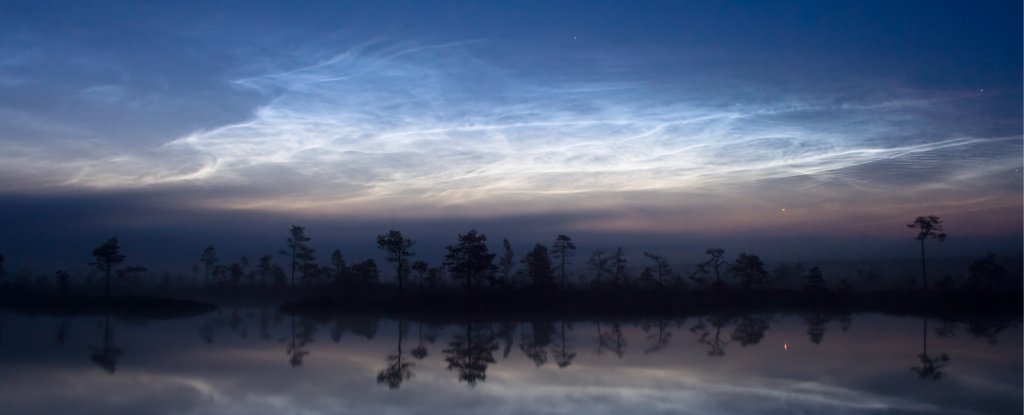
While greenhouse gases are heating the Earth’s surface, they are also causing rapid cooling well above us, at the edge of space.
In fact, the atmosphere greater than about 90 kilometers (56 miles) above Antarctica is cooling at a rate 10 times faster than the average warming on the planet’s surface.
Our new research has accurately measured this cooling rate and revealed an important discovery: a new four-year temperature cycle in the polar atmosphere. The results, based on 24 years of continuous measurements by Australian scientists in Antarctica, were published in two articles this month.
The findings show that Earth’s upper atmosphere, in a region called the “mesosphere,” is extremely sensitive to increasing concentrations of greenhouse gases. This provides a new opportunity to monitor how well government interventions to reduce emissions are working.
Our project also monitors the spectacular natural phenomenon known as “noctilucent” or “night” clouds. While beautiful, the most frequent occurrence of these clouds is considered a bad sign for climate change.
Studying the ‘airglow’
Since the 1990s, scientists at Australia’s Davis Research Station have taken more than 600,000 measurements of the temperatures in the upper atmosphere over Antarctica. We have done this using sensitive optical instruments called spectrometers.
These instruments analyze the infrared brightness radiated by so-called hydroxyl molecules, which exist in a thin layer about 87 kilometers (54 miles) above the Earth’s surface. This “airglow” allows us to measure the temperature in this part of the atmosphere.
Our results show that in the upper atmosphere over Antarctica, carbon dioxide and other greenhouse gases do not have the warming effect they do in the lower atmosphere (by colliding with other molecules). Instead, excess energy radiates into space, causing a cooling effect.
Our new research more accurately determines this cooling rate. For 24 years, the temperature of the upper atmosphere has cooled to about 3 degrees C, or 1.2 degrees C per decade. That’s about ten times greater than the average warming in the lower atmosphere, about 1.3 degrees C in the last century.
Unraveling natural cues
The increase in greenhouse gas emissions is contributing to the temperature changes we have registered, but other influences are also influencing. These include the seasonal cycle (warmer in winter, colder in summer) and the 11-year cycle of activity of the Sun (involving quieter and more intense solar periods) in the mesosphere.
One of the challenges of the research was to untangle all these merged “signals” to determine to what extent each was driving the changes we observed.
Surprisingly in this process, we discovered a new, previously unidentified natural cycle in the upper polar atmosphere. In this four-year cycle that we call Quasi-Quadrennial Oscillation (QQO), temperatures vary by 3-4 degrees C in the upper atmosphere.
Discovering this cycle was like tripping over a gold nugget on a well-crafted claim. More work is needed to determine its origin and full importance.
But the finding has major implications for climate modeling. The physics that drive this cycle are unlikely to be included in the global models currently used to predict climate change. But a variation of 3-4 degrees C every four years is a great sign to ignore.
We still don’t know what drives the oscillation. But whatever the answer, it also appears to affect winds, sea surface temperatures, atmospheric pressure, and sea ice concentrations around Antarctica.
‘Bright at night’ clouds
Our research also monitors how cooling temperatures are affecting the occurrence of noctilucent or “night” clouds.
Noctilucent clouds are very rare: Since the Australian Antarctic stations we have recorded about ten observations since 1998. They occur at an altitude of approximately 80 kilometers (50 miles) in the polar regions during the summer. You can only see them from the ground when the sun is below the horizon during twilight, but it still shines in the upper atmosphere.
The clouds appear as thin, wavy, pale blue filaments. They are made up of ice crystals and require temperatures around minus 130 degrees C (266 F) to form. Although impressive, noctilucent clouds are considered a “coal mine canary” of climate change. Further cooling of the upper atmosphere as a result of greenhouse gas emissions will likely lead to more frequent noctilucent clouds.
There is already evidence that clouds are becoming brighter and more widespread in the northern hemisphere.
Measurement change
Human-induced climate change threatens to radically alter living conditions on our planet. Over the next few decades, less than a lifetime, the average global air temperature is expected to rise, bringing with it a rise in sea level, extreme weather conditions, and changes in ecosystems around the world.
Long-term monitoring is important to measure change and to test and calibrate increasingly complex climate models. Our results contribute to a global network of observations coordinated by the Mesospheric Change Detection Network for this purpose.
The accuracy of these models is critical in determining whether government and other interventions to curb climate change are truly effective. ![]()
John French, atmospheric physicist, University of Tasmania; Andrew Klekociuk, Principal Scientific Investigator, Australian Antarctic Division and Associate Professor, University of Tasmania, and Frank Mulligan, National University of Ireland Maynooth.
This article is republished from The Conversation under a Creative Commons license. Read the original article.
.